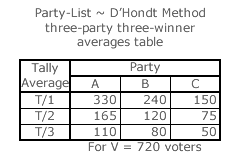Comparisons: Party-List ~ D'Hondt
Description of the D'Hondt Method
This method employs the highest averages approach to seat allocation in the party-list voting system as described in the earlier party-list section. For an election with W seats/winners, the D'Hondt divisors are 1, 2, 3, 4 and so on until W. In other words, they form a linear sequence of consecutive integers from 1 to W. If a party wins X seats with a tally of T, then the average number of voters represented by each winner is T/X. By electing the W candidates with the W highest averages regardless of their party affiliation, then the maximum number of voters are represented by those elected winners.
For a detailed and comprehensive outline description of the D'Hondt Party-List method, please visit the voting system section of Wikipedia or another reference source.
D'Hondt Method Election Example

To enable a comparison with the Hare and Droop Quota methods, consider once again the previous three-party three-winner election example but now using the D'Hondt divisors of 1, 2 and 3 to establish the key averages. Parties A, B and C still respectively each receive an 11/24, 8/24 and 5/24 share of the vote. For a nominal total tally of 720 valid votes, the table opposite shows the three candidate averages for each party. The three highest averages are highlighted in white in this table. Therefore, parties A, B and C gain two, one and zero seats respectively.
For parties A:B:C, the seat ratio is hence 2:1:0 for the tally ratio of 11:8:5. This outcome is also one of the two tied results (to be resolved by random selection) when using the Droop Quota method; where the other outcome is the optimal seat ratio of 1:1:1. The Hare Quota only generates this latter optimal outcome. Employing the D'Hondt method here, results in a non-optimal outcome that favours the largest party over the smallest one.
D'Hondt Method Map Construction
Before comparing this method to the party-list CHPV voting system, its own properties must first be established. As with CHPV, issues regarding optimality, party cloning and disproportionality can be addressed once a variety of multiple-party multiple-winner maps have been constructed.
In the following section, the featured two-party and three-party maps for this method are presented without any explanation of their construction. For those advanced visitors to this website who wish to understand how such maps are constructed or who wish to construct ones that are not featured for themselves, then please refer to the Map Construction appendix for either the Two-Party D'Hondt Method Maps or the Three-Party D'Hondt Method Maps page.
Proceed to next section > Comparisons: D'Hondt ~ Maps
Return to previous page > Comparisons: Droop Quota ~ Proportionality 3
